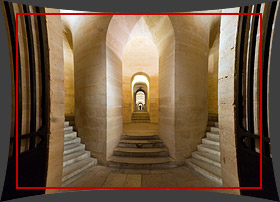DISTORTION: BARREL, PINCUSHION & PERSPECTIVE
This can give otherwise straight lines the appearance of bending inward or outward, and can influence the depiction of depth: Pincushion Distortion
Pincushion Distortion Barrel Distortion
Barrel Distortion Perspective "Distortion"
Perspective "Distortion"
Blue dot represents direction of camera;
red lines mark converging parallel lines.
red lines mark converging parallel lines.
- Pincushion Distortion. Appears when otherwise straight lines curve inward. Typically caused by telephoto lenses, or at the telephoto end of a zoom lens.
- Barrel Distortion. Appears when otherwise straight lines curve outward. Typically caused by wide angle lenses, or at the wide end of a zoom lens.
- Perspective Distortion*. Appears when otherwise parallel lines converge. Caused by the camera not facing these parallel lines perpendicularly; with trees and architecture, this usually means that the camera isn't pointed at the horizon.
*Technical Note:
Perspective distortion isn't technically a true distortion because it
is a natural characteristic of 3D vision. We see it with our own eyes,
but our mind knows the correct 3D positioning of objects and therefore
doesn't perceive these lines as converging. For more, also see the
tutorials on wide angle lenses and using tilt/shift lenses to control perspective.
Correction. Fortunately, each of the above types of
distortion is correctable. However, this should only be performed when
necessary, such as with subjects that include straight lines or are
highly geometric. Architectural photography is often most sensitive, for
example, whereas many landscapes aren't noticeably affected.
distortion correction sliders in photoshop
Disadvantages. Distortion correction usually requires cropping out curved edges of the corrected frame, which can influence composition. Correction also redistributes an image's resolution; with pincushion removal, the edges will appear slightly sharper (at the expense of the center), whereas with barrel removal the center will instead appear slightly sharper (at the expense of the edges). With wide angle lenses, barrel distortion is actually a helpful way of offsetting the corner softening that is common with these lenses, for example.
No comments:
Post a Comment